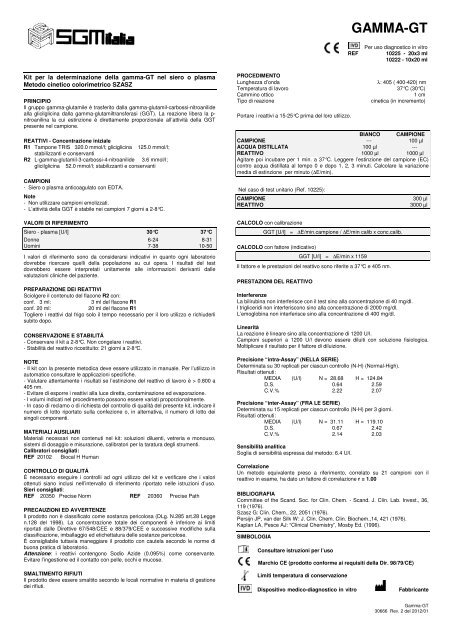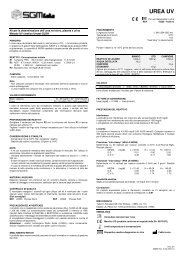GAMMA-GT - Sgmitalia.com
GAMMA-GT - Sgmitalia.com
GAMMA-GT - Sgmitalia.com
You also want an ePaper? Increase the reach of your titles
YUMPU automatically turns print PDFs into web optimized ePapers that Google loves.
Kit per la determinazione della gamma-<strong>GT</strong> nel siero o plasma<br />
Metodo cinetico colorimetrico SZASZ<br />
PRINCIPIO<br />
Il gruppo gamma-glutamile è trasferito dalla gamma-glutamil-carbossi-nitroanilide<br />
alla glicilglicina dalla gamma-glutamiltransferasi (G<strong>GT</strong>). La reazione libera la pnitroanilina<br />
la cui estinzione è direttamente proporzionale all’attività della G<strong>GT</strong><br />
presente nel campione.<br />
REATTIVI - Concentrazione iniziale<br />
R1 Tampone TRIS 320.0 mmol/l; gliciglicina 125.0 mmol/l;<br />
stabilizzanti e conservanti<br />
R2 L-gamma-glutamil-3-carbossi-4-nitroanilide 3.6 mmol/l;<br />
glicilglicina 52.0 mmol/l; stabilizzanti e conservanti<br />
CAMPIONI<br />
- Siero o plasma anticoagulato con EDTA.<br />
Note<br />
- Non utilizzare campioni emolizzati.<br />
- L’attività della G<strong>GT</strong> è stabile nei campioni 7 giorni a 2-8°C.<br />
VALORI DI RIFERIMENTO<br />
Siero - plasma [U/l] 30°C 37°C<br />
Donne 6-24 8-31<br />
Uomini 7-38 10-50<br />
I valori di riferimento sono da considerarsi indicativi in quanto ogni laboratorio<br />
dovrebbe ricercare quelli della popolazione su cui opera. I risultati del test<br />
dovrebbero essere interpretati unitamente alle informazioni derivanti dalle<br />
valutazioni cliniche del paziente.<br />
PREPARAZIONE DEI REATTIVI<br />
Sciolgere il contenuto del flacone R2 con:<br />
conf. 3 ml: 3 ml del flacone R1<br />
conf. 20 ml: 20 ml del flacone R1<br />
Togliere i reattivi dal frigo solo il tempo necessario per il loro utilizzo e richiuderli<br />
subito dopo.<br />
CONSERVAZIONE E STABILITÁ<br />
- Conservare il kit a 2-8°C. Non congelare i reattivi.<br />
- Stabilità del reattivo ricostituito: 21 giorni a 2-8°C.<br />
NOTE<br />
- Il kit con la presente metodica deve essere utilizzato in manuale. Per l’utilizzo in<br />
automatico consultare le applicazioni specifiche.<br />
- Valutare attentamente i risultati se l’estinzione del reattivo di lavoro è > 0.800 a<br />
405 nm.<br />
- Evitare di esporre i reattivi alla luce diretta, contaminazione ed evaporazione.<br />
- I volumi indicati nel procedimento possono essere variati proporzionalmente.<br />
- In caso di reclamo o di richiesta del controllo di qualità del presente kit, indicare il<br />
numero di lotto riportato sulla confezione o, in alternativa, il numero di lotto dei<br />
singoli <strong>com</strong>ponenti.<br />
MATERIALI AUSILIARI<br />
Materiali necessari non contenuti nel kit: soluzioni diluenti, vetreria e monouso,<br />
sistemi di dosaggio e misurazione, calibratori per la taratura degli strumenti.<br />
Calibratori consigliati:<br />
REF 20102 Biocal H Human<br />
CONTROLLO DI QUALITÁ<br />
É necessario eseguire i controlli ad ogni utilizzo del kit e verificare che i valori<br />
ottenuti siano inclusi nell’intervallo di riferimento riportato nelle istruzioni d’uso.<br />
Sieri consigliati:<br />
REF 20350 Precise Norm REF 20360 Precise Path<br />
PRECAUZIONI ED AVVERTENZE<br />
Il prodotto non è classificato <strong>com</strong>e sostanza pericolosa (DLg. N.285 art.28 Legge<br />
n.128 del 1998). La concentrazione totale dei <strong>com</strong>ponenti è inferiore ai limiti<br />
riportati dalle Direttive 67/548/CEE e 88/379/CEE e successive modifiche sulla<br />
classificazione, imballaggio ed etichettatura delle sostanze pericolose.<br />
É consigliabile tuttavia maneggiare il prodotto con cautela secondo le norme di<br />
buona pratica di laboratorio.<br />
Attenzione: i reattivi contengono Sodio Azide (0.095%) <strong>com</strong>e conservante.<br />
Evitare l’ingestione ed il contatto con pelle, occhi e mucose.<br />
SMALTIMENTO RIFIUTI<br />
Il prodotto deve essere smaltito secondo le locali normative in materia di gestione<br />
dei rifiuti.<br />
<strong>GAMMA</strong>-<strong>GT</strong><br />
Per uso diagnostico in vitro<br />
REF 10225 - 20x3 ml<br />
10222 - 10x20 ml<br />
PROCEDIMENTO<br />
Lunghezza d’onda λ: 405 ( 400-420) nm<br />
Temperatura di lavoro 37°C (30°C)<br />
Cammino ottico 1 cm<br />
Tipo di reazione cinetica (in incremento)<br />
Portare i reattivi a 15-25°C prima del loro utilizzo.<br />
BIANCO CAMPIONE<br />
CAMPIONE --- 100 µl<br />
ACQUA DISTILLATA 100 µl ---<br />
REATTIVO 1000 µl 1000 µl<br />
Agitare poi incubare per 1 min. a 37°C. Leggere l’estinzione del campione (EC)<br />
contro acqua distillata al tempo 0 e dopo 1, 2, 3 minuti. Calcolare la variazione<br />
media di estinzione per minuto (∆E/min).<br />
Nel caso di test unitario (Ref. 10225):<br />
CAMPIONE 300 µl<br />
REATTIVO 3000 µl<br />
CALCOLO con calibrazione<br />
G<strong>GT</strong> [U/l] = ∆E/min.campione / ∆E/min calib x conc.calib.<br />
CALCOLO con fattore (indicativo)<br />
G<strong>GT</strong> [U/l] = ∆E/min x 1159<br />
Il fattore e le prestazioni del reattivo sono riferite a 37°C e 405 nm.<br />
PRESTAZIONI DEL REATTIVO<br />
Interferenze<br />
La bilirubina non interferisce con il test sino alla concentrazione di 40 mg/dl.<br />
I trigliceridi non interferiscono sino alla concentrazione di 2000 mg/dl.<br />
L’emoglobina non interferisce sino alla concentrazione di 400 mg/dl.<br />
Linearità<br />
La reazione è lineare sino alla concentrazione di 1200 U/l.<br />
Campioni superiori a 1200 U/l devono essere diluiti con soluzione fisiologica.<br />
Moltiplicare il risultato per il fattore di diluizione.<br />
Precisione “intra-Assay” (NELLA SERIE)<br />
Determinata su 30 replicati per ciascun controllo (N-H) (Normal-High).<br />
Risultati ottenuti:<br />
MEDIA (U/l) N = 28.68 H = 124.84<br />
D.S. 0.64 2.59<br />
C.V.% 2.22 2.07<br />
Precisione “inter-Assay” (FRA LE SERIE)<br />
Determinata su 15 replicati per ciascun controllo (N-H) per 3 giorni.<br />
Risultati ottenuti:<br />
MEDIA (U/l) N = 31.11 H = 119.10<br />
D.S. 0.67 2.42<br />
C.V.% 2.14 2.03<br />
Sensibilità analitica<br />
Soglia di sensibilità espressa dal metodo: 6.4 U/l.<br />
Correlazione<br />
Un metodo equivalente preso a riferimento, correlato su 21 campioni con il<br />
reattivo in esame, ha dato un fattore di correlazione r = 1.00<br />
BIBLIOGRAFIA<br />
Committee of the Scand. Soc. for Clin. Chem. - Scand. J. Clin. Lab. Invest., 36,<br />
119 (1976).<br />
Szasz G: Clin. Chem., 22, 2051 (1976).<br />
Persijn JP, van der Silk W: J. Clin. Chem. Clin. Biochem.,14, 421 (1976).<br />
Kaplan LA, Pesce AJ: “Clinical Chemistry”, Mosby Ed. (1996).<br />
SIMBOLOGIA<br />
Consultare istruzioni per l’uso<br />
Marchio CE (prodotto conforme ai requisiti della Dir. 98/79/CE)<br />
Limiti temperatura di conservazione<br />
Dispositivo medico-diagnostico in vitro Fabbricante<br />
Gamma-<strong>GT</strong><br />
30666 Rev. 2 del 2012/01
Kit for measurement of gamma-<strong>GT</strong> in serum or plasma<br />
Kinetic colorimetric SZASZ method<br />
PRINCIPLE<br />
Gamma-glutamyl group is transferred from gamma-glutamyl-carboxy-nitroanilide<br />
to glycyglycine by gamma-glutamyltransferase (G<strong>GT</strong>). The reaction releases pnitroaniline<br />
whose absorbance is directly proportional to the G<strong>GT</strong> activity in the<br />
sample.<br />
REAGENTS<br />
R1 TRIS buffer 320.0 mmol/l; glycylglycine 125.0 mmol/l;<br />
stabilizers and preservatives<br />
R2 L-gamma-glutamyl-3-carboxy-4-nitroanilide 3.6 mmol/l;<br />
glycylglycine 52.0 mmol/l; stabilizers and preservatives<br />
SAMPLE<br />
- Serum or EDTA plasma.<br />
Note<br />
- Do not use samples with haemolysis.<br />
- The G<strong>GT</strong> activity is stable in the samples 7 days at 2-8°C.<br />
REFERENCE VALUES<br />
Serum - plasma [U/l] 30°C 37°C<br />
Women 6-24 8-31<br />
Men 7-38 10-50<br />
References values are considered indicatives since each laboratory should<br />
establish references ranges for its own patient’s population. The analytical results<br />
should be evaluated with other information <strong>com</strong>ing from patient’s clinical story.<br />
PREPARATION OF REAGENTS<br />
Dissolve the content of R2 vial with:<br />
vial 3 ml: 3 ml of R1 solution<br />
vial 20 ml: 20 ml of R1 solution<br />
Keep out the reagents from refrigerator only for the use and recap them<br />
immediately.<br />
STORAGE AND STABILITY<br />
- Store the kit at 2-8°C. Do not freeze the reagents.<br />
- Reconstituted reagent stability: 21 days at 2-8°C.<br />
NOTE<br />
- The kit, according to this method, must be used in manual procedures. About<br />
automatic using follow specific applications.<br />
- Evaluate carefully the results if working reagent absorbance is > 0.800 at<br />
405 nm.<br />
- Avoid direct light, contamination and evaporation.<br />
- The volumes in the procedure can be changed proportionally.<br />
- In case of <strong>com</strong>plaint or quality control request, refer to the lot number on the<br />
package or the lot number on the singles vials.<br />
AUXILIARY EQUIPMENT<br />
Materials not included in the kit: diluent solutions, laboratory glassware,<br />
disposable tips, photometers and calibrators.<br />
Suggested calibrator:<br />
REF 20102 Biocal H Human<br />
QUALITY CONTROLS<br />
It’s necessary, every time the kit is used, to make the quality controls and to check<br />
that values obtained are within the acceptance range provided in the insert.<br />
Suggested serum:<br />
REF 20350 Precise Norm REF 20360 Precise Path<br />
PRECAUTION IN USE<br />
The product is not classified as dangerous (DLg. N. 285 art. 28 l. n. 128/1998).<br />
The total concentration of <strong>com</strong>ponents is lower than the limits reported by 67/548<br />
and 88/379 CE Regulations (and following modifications) about classification,<br />
packaging and labelling of dangerous substances.<br />
However the reagent should be handled with caution, according to good laboratory<br />
practice.<br />
Caution: the reagents contain Sodium Azide (0.095%) as preservative. Avoid<br />
swallowing and contacting with skin, eyes and mucous membranes.<br />
WASTE MANAGEMENT<br />
Please refer to the local legal requirements.<br />
<strong>GAMMA</strong>-<strong>GT</strong><br />
For in vitro medical device<br />
REF 10225 - 20x3 ml<br />
10222 - 10x20 ml<br />
PROCEDURE<br />
Wavelength λ: 405 (400-420) nm<br />
Working temperature 37°C (30°C)<br />
Optical path 1 cm<br />
Reaction Kinetic (increasing)<br />
Bring the reagents at 15-25°C before using them.<br />
BLANK SAMPLE<br />
SAMPLE --- 100 µl<br />
DISTILLED WATER 100 µl ---<br />
REAGENT 1000 µl 1000 µl<br />
Mix, then incubate for 1’ a 37°C. Measure the absorbance of sample (EC) against<br />
distilled water every minute during 3 minutes. Calculate the average absorbance<br />
difference per minute (∆E/min).<br />
In case of unitary test (Ref. 10225):<br />
SAMPLE 300 µl<br />
REAGENT 3000 µl<br />
CALCULATION with calibration<br />
G<strong>GT</strong> [U/l] = ∆E/min. sample / ∆E/min calib x conc.calib.<br />
CALCULATION with factor (indicative)<br />
G<strong>GT</strong> [U/l] = ∆E/min x 1159<br />
The factor and the reagent performances are related to 37°C and 405 nm.<br />
ANALYTICAL PERFORMANCES<br />
Interferences<br />
Bilirubin does not interfere up to concentration of 40 mg/dl.<br />
Triglycerides do not interfere up to concentration of 2000 mg/dl.<br />
Hemoglobin does not interfere up to concentration of 400 mg/dl.<br />
Linearity<br />
Reaction is linear up to a concentration of 1200 U/l. Samples with values<br />
exceeding 1200 U/l must be diluted with saline solution. Multiply, then, the result<br />
for diluting factor.<br />
“Intra-Assay” precision (within-Run)<br />
Determined on 30 samples for each control (N-H) (Normal-High).<br />
Results:<br />
MEAN (U/l) N = 28.68 H = 124.84<br />
S.D: 0.64 2.59<br />
V.C. % 2.22 2.07<br />
“Inter-Assay” precision (between-run)<br />
Determined on 15 samples for each control (N-H) for 3 days.<br />
Results:<br />
MEAN (U/l) N = 31.11 H = 119.10<br />
S.D. 0.67 2.42<br />
V.C. % 2.14 2.03<br />
Analytical sensitivity<br />
The test sensitivity in terms of detection limit is 6.4 U/l.<br />
Correlation<br />
A study based <strong>com</strong>paring this method with a similar method on 21 samples has<br />
given a correlating factor r = 1.00<br />
BIBLIOGRAPHY<br />
Committee of the Scand. Soc. for Clin. Chem. - Scand. J. Clin. Lab. Invest., 36,<br />
119 (1976).<br />
Szasz G: Clin. Chem., 22, 2051 (1976).<br />
Persijn JP, van der Silk W: J. Clin. Chem. Clin. Biochem.,14, 421 (1976).<br />
Kaplan LA, Pesce AJ: “Clinical Chemistry”, Mosby Ed. (1996).<br />
SYMBOLS<br />
Read instruction for use<br />
CE mark (requirement of 98/79 regulation)<br />
Storaging temperature limits<br />
In vitro medical device Producer<br />
Gamma-<strong>GT</strong><br />
30666 Rev. 2 of 2012/01
















